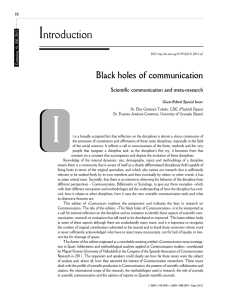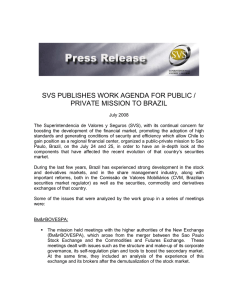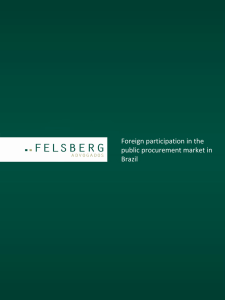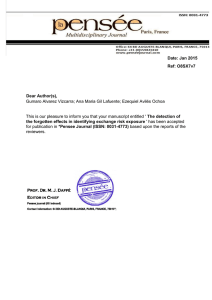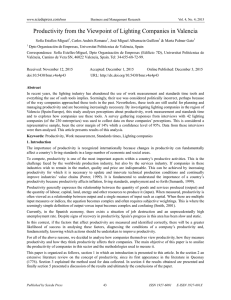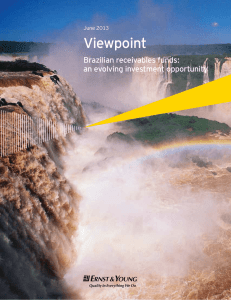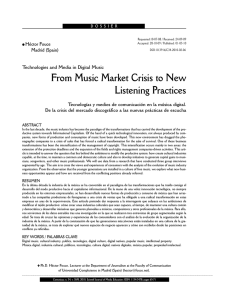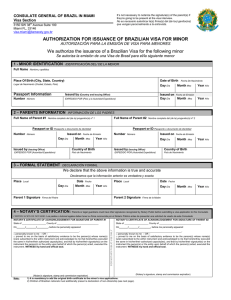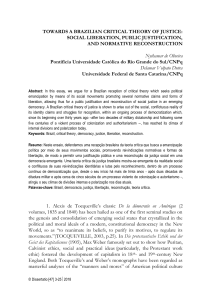Media Education and Brazilian Educational Policies for the
Anuncio
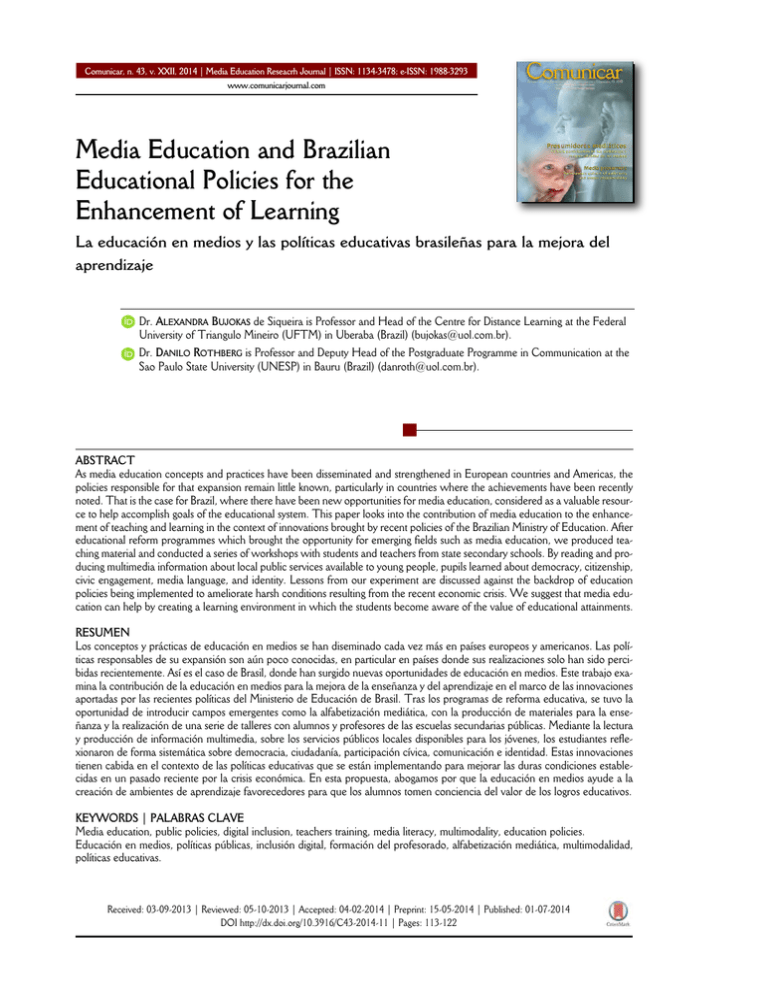
Comunicar, n. 43, v. XXII, 2014 | Media Education Reseacrh Journal | ISSN: 1134-3478; e-ISSN: 1988-3293 www.comunicarjournal.com Media Education and Brazilian Educational Policies for the Enhancement of Learning La educación en medios y las políticas educativas brasileñas para la mejora del aprendizaje Dr. ALEXANDRA BUJOKAS de Siqueira is Professor and Head of the Centre for Distance Learning at the Federal University of Triangulo Mineiro (UFTM) in Uberaba (Brazil) ([email protected]). Dr. DANILO ROTHBERG is Professor and Deputy Head of the Postgraduate Programme in Communication at the Sao Paulo State University (UNESP) in Bauru (Brazil) ([email protected]). ABSTRACT As media education concepts and practices have been disseminated and strengthened in European countries and Americas, the policies responsible for that expansion remain little known, particularly in countries where the achievements have been recently noted. That is the case for Brazil, where there have been new opportunities for media education, considered as a valuable resource to help accomplish goals of the educational system. This paper looks into the contribution of media education to the enhancement of teaching and learning in the context of innovations brought by recent policies of the Brazilian Ministry of Education. After educational reform programmes which brought the opportunity for emerging fields such as media education, we produced teaching material and conducted a series of workshops with students and teachers from state secondary schools. By reading and producing multimedia information about local public services available to young people, pupils learned about democracy, citizenship, civic engagement, media language, and identity. Lessons from our experiment are discussed against the backdrop of education policies being implemented to ameliorate harsh conditions resulting from the recent economic crisis. We suggest that media education can help by creating a learning environment in which the students become aware of the value of educational attainments. RESUMEN Los conceptos y prácticas de educación en medios se han diseminado cada vez más en países europeos y americanos. Las políticas responsables de su expansión son aún poco conocidas, en particular en países donde sus realizaciones solo han sido percibidas recientemente. Así es el caso de Brasil, donde han surgido nuevas oportunidades de educación en medios. Este trabajo examina la contribución de la educación en medios para la mejora de la enseñanza y del aprendizaje en el marco de las innovaciones aportadas por las recientes políticas del Ministerio de Educación de Brasil. Tras los programas de reforma educativa, se tuvo la oportunidad de introducir campos emergentes como la alfabetización mediática, con la producción de materiales para la enseñanza y la realización de una serie de talleres con alumnos y profesores de las escuelas secundarias públicas. Mediante la lectura y producción de información multimedia, sobre los servicios públicos locales disponibles para los jóvenes, los estudiantes reflexionaron de forma sistemática sobre democracia, ciudadanía, participación cívica, comunicación e identidad. Estas innovaciones tienen cabida en el contexto de las políticas educativas que se están implementando para mejorar las duras condiciones establecidas en un pasado reciente por la crisis económica. En esta propuesta, abogamos por que la educación en medios ayude a la creación de ambientes de aprendizaje favorecedores para que los alumnos tomen conciencia del valor de los logros educativos. KEYWORDS | PALABRAS CLAVE Media education, public policies, digital inclusion, teachers training, media literacy, multimodality, education policies. Educación en medios, políticas públicas, inclusión digital, formación del profesorado, alfabetización mediática, multimodalidad, políticas educativas. Received: 03-09-2013 | Reviewed: 05-10-2013 | Accepted: 04-02-2014 | Preprint: 15-05-2014 | Published: 01-07-2014 DOI http://dx.doi.org/10.3916/C43-2014-11 | Pages: 113-122 Comunicar, 43, XXII, 2014 114 1. Introduction As media education concepts and practices have been disseminated and strengthened more and more in European countries and Americas, the policies responsible for that expansion remain little known, particularly in countries where the achievements have been recently noted. That is the case for Brazil, where there have been new opportunities for media education, considered as a valuable resource to help accomplish goals of the educational system. Here, we examine the contribution of media education to the enhancement of teaching and learning in the context of innovations brought about by recent policies of the Capes (Brazilian abbreviation for Coordination for the Improvement of Higher Level Personnel), a department of the Brazilian Ministry of Education (MEC). The Capes’ Directorate of Elementary Education (DEB), which completed its fifth anniversary in 2012, has been funding creative approaches under the scope of programmes conceived to help change the poor performance detected by evaluations such as the Programme for International Student Assessment (PISA), in which Brazil scored 53rd out of 65 countries assessed by the OECD (Organization for Economic Co-operation and Development) in 2009 (OECD, 2009). The usual explanations for that position range from low investment in education due to the economic crisis in the 1980s and 1990s, overemphasis on theory in teachers’ degrees, which neglect pedagogical practic, to the persistence of a great number of classes failing to attract and sustain students’ interest in a rapidly changing technological environment and labour market. Striving to overcome that crisis, MEC policies designed a variety of approaches, bringing opportunities to the development of emerging fields such as media education in Brazil. In the Media Lab of the Federal University of Triangulo Mineiro, currently one of the top ten universities in the country, thanks in part to the MEC programmes, we chose radical democracy, cultural studies, mediatization and multimodality as the core concepts of the theoretical framework which shaped a series of workshops conducted with students and teachers from state secondary schools. We produced teaching materials which applied key concepts of media education: language, audiences, media institutions and representation. By reading and producing multimedia information about local public services available to young people, pupils learned about democracy, citizenship, civic engagement, media language, and identity. The results show that the students think of media education as a way to foster language skills and technology use as tools to become well-informed about citizenship rights, although they remain sceptical about the current curriculum being receptive to such an approach. Inadequate school facilities and unprepared teachers are the main obstacles to media education, according to the students’ perspectives. Teachers agree with that view and see themselves as victims of low investment in schools and teachers training programmes. Lessons from our experiment are discussed against the backdrop of education policies being implemented to ameliorate harsh conditions set off in the past by an economic crisis. We suggest that media education can help by creating a learning environment in which the students become aware of the value of educational attainments. The existing democratic systems place particular emphasis on the role of education in disseminating an understanding of citizenship as a state of equality of rights in every dimension of social life, comprising access to work, living, health, and education itself. That is why the effectiveness of national education policies has been assessed in part by the schools’ ability to promote social inclusion, particularly with respect to the young people, who are expected to develop the skills they need to flourish and prosper in a competitive labour market, regardless of their social or ethnic background (Unesco, 2012; Santos, 1999). While this has been true at least since the beginning of the 20th century, for most of the electoral democracies, changes in the last thirty years brought new demands for educational systems and policies. Current society seems to be one in which the socalled radical democracy has been more and more feasible. From the lonely citizen signing e-petitions and joining chats and forums discussing politics to largely organized online social movements and consumer social networks, there is enough evidence to support the view that which schools cannot ignore those new expressions of political engagement and the skills needed for the average citizen to exert power responsibly (Coleman & Blumler, 2009; Dahlberg & Siapera, 2007). Given the enlargement of the political domain, one of the goals embraced by schools turned out to be encouraging students to look into their communities in search for what should be done in terms of remedying poor social and health care, unfair distribution of work, leisure, and opportunities, and how advocacy and social mobilization may help the call for change (Mouffe, 1996; Freire, 2004). One of the prominent © ISSN: 1134-3478 • e-ISSN: 1988-3293 • Pages 113-122 skills then required is acquiring, selecting and organiA better understanding of the two-way process of zing pieces of information from many sources, incluinfluences and interactions would emerge from that ding commercial and public media, and assemble them exercise, helping to create a healthy criticism about the in order to construct messages which everyone could media strategies for attracting audiences, which becaunderstand, in the most attractive form, and also on me one of the primary goals of media education. the internet. Abilities of negotiation of meaning beFrom the Cultural Studies perspective, the audiencome essential in the process of coding and decoding ce does not receive media content passively, but active messages. reception cannot be assumed either. There can be Media education appears to be a research field always detected a hegemonic code guiding reception; capable of bringing about the knowledge many educastill, one’s own experiences and cultural background tors are looking for, as they feel that online social actiprovide parameters to a potentially intensive negotiavism turned to be one more dimension in which stution of meaning, and the outcome of that reception dents could be included. Media education techniques process, even when reject primary ideas, may be limiare key to assist with the challenges brought by ICT to ted by their scope. democracy, as they address negotiation of meaning in complex social interactions. The results show that the students think of media education Media education studies can shed light over the comas a way to foster language skills and technology use as tools prehension of mental operations underlying the process of to become well informed about citizenship rights, although meaning construction, particuthey remain sceptical about the current curriculum being larly those influenced by the Cultural Studies and its Latin receptive to such an approach. American correlated field named Mediation Theory, which have been useful to elucidate the various aspects which bear on that process (Hall & Whannel, 1964; Martín-Barbero (1993) added to Cultural Studies Hall, 1980; Martín-Barbero, 1993). by clarifying other elements involved in the negotiation In an attempt to overcome the inoculation of media of meaning, especially those which would be more theory, which supposes the existence of a direct causal usual in Latin American countries, in which broadcasrelation between the message and the behavior it ting is massively dominated by the commercial sector, would be intended to generate, Hall and Whannel with a residual presence of public channels, and huge (1964) argued that schools should be concerned to social inequalities are accompanied by widespread grasp not what the media did to people, but what peolow educational attainments. ple did with the media. Although they were speaking of In the region, the stark contrast between the rhethe old media, many of their insights remain up-to-date. toric of happiness and endless well-being passed on by For Hall and Whannel (1964), the media comthe media and the poverty of the majority imposed municate conflicting ideas about society’s rules and investigations on what had been hidden from the beliefs for the youth, and so young people must, with representations of t national daily life. When a nation their teachers’ guidance, question the accuracy of the finds mainly distorted images of itself on the screen, interpretations of social life implied in those ideas, by Martín-Barbero (1993) claimed that it is necessary to comparing images and stereotypes diffused by mass expose the links (which otherwise would be covert) communication with their own life experiences and between aspects such as media ownership and sterevalues. «We need the critical and evaluative approach otypes often presented as a national character; state precisely because the media themselves, their content authoritarianism and social alienation in national teleand forms, are not neutral: we have to attend to the vision programming; social class, gender, ethnicity and forms within the new experiences are being presenpatterns of message interpretation. «The unquestionated, to discriminate between values, and to analyse ble central role that media play in today’s world seems our responses to them carefully» (Hall & Whannel, disproportionate and paradoxical in countries in Latin 1964: 46). America where basic needs in education and health © ISSN: 1134-3478 • e-ISSN: 1988-3293 • Pages 113-122 Comunicar, 43, XXII, 2014 115 Comunicar, 43, XXII, 2014 116 have not yet been met», which leads to a context in which the reconstruction of value systems, ethical norms and civic virtues «demands our continuous effort to disentangle the increasingly complex fabric of mediations that articulates the relations between communication, culture and politics», argues MartínBarbero (2006: 280-281). Cultural Studies and Mediation Theory have an impact on media education research as they pose the need for the development of techniques adequate for decoding media messages often embedded in matters ned, the outcome of a negotiation of meaning will probably be shaped by how components are assembled. Power relations should also be exposed as they can determine the logic of a particular assemblage: «signs are motivated conjunctions of form and meaning; that conjunction is based on the interest of the sign-maker using culturally available resources», according to Kress (2010: 10). Power can be noted in the form of a particular cultural perspective guiding the construction of a frame: «what sorts of things are framed, how they are framed, what kinds of frames there are, and so on, and these will vary from culture to culture» (Kress, 2010: 10). The theoretical approach Current society seems to be one in which the so-called summarized above lays the ground for a media education radical democracy has been more and more feasible. From proposal, which must provide the lonely citizen signing e-petitions and joining chats and answers for a crucial starting interrogation: how do the forums discussing politics to largely organized online social media teach, after all? The media organize ideas; dissemimovements and consumer social networks, there is enough nate values; create and reinforce expectations; and offer evidence to support the view that which schools cannot behavioral models, according ignore those new expressions of political engagement and to Cortés (2005: 55), who reminds us about the inevitabithe skills needed for the average citizen to exert power lity of such influence: «the mass media teach whether or responsibly. not mediamakers intend to or realize it. And users learn from the media whether or not they of a complex political and cultural nature, imbricated try or are even aware of it», so the media should be in their production. Media literacy reinforce the case considered in terms of an «informal yet omnipresent for deepening the students’ cultural background, up to non-school textbooks». a point from where they will more likely be able to In order to have autonomy from the media, one become aware of their own process of negotiation of must learn how to recognise the manufactured nature meaning, construct alternative readings and justify of the information; identify the ways by which the these in terms or their political and cultural affiliations. media make representations; create explanations For its turn, the production of various readings opens about how we learn, being constantly exposed to the research field for multimodality theory (Kress, media messages, fictional and non-fictional, during a 2000). life time. Web pages are obviously multimodal, as they can We support the claim that such skills can be devestimulate human perception through pictures, video loped through teaching activities supported by four key and audio clips, and animations. Human speech is also concepts of media education (Lusted, 1991; Buckinmultimodal, as it comes with intonation and facial gham, 2003; QCA, 2003; Unesco, 2011), namely: a) expressions. As long as it explores many semiotic language: as media messages result from choices and modes or communication channels, the media should strategies that frame reality, teachers should approach be studied as a combination of signs, which produce a them by questioning how meaning was constructed particular meaning only because they are perceived as through professional practices, which are not neutral an assemblage. Although separate signs may have their and carry the weight of industry standards and corpoown isolated meaning, which also should be examirate values; b) audience: as media effects cannot be © ISSN: 1134-3478 • e-ISSN: 1988-3293 • Pages 113-122 taken for granted, and a text may not have meaning outside of certain cultural assumptions, teachers should explore ambivalences which may or may not be perceived by some fractions of the audience, by striking a balance between the text structure and the predisposition of interpretive communities; c) media institutions: teachers should always have in mind that news values, for example, are typically conveyed within newsrooms by journalists in terms of what the field of interpretive anthropology defines as local knowledge, i.e., they are not objective at all, and are heavily dependent on rites and traditions which serve the essential purpose of increasing the audience; d) representation: as messages can be taken either as a mirror of reality or a lie, teachers must have in mind that representations are attached to identities, which vary according to the public or the producers’ intentionality. As our media education activities proposal was intended to explore opportunities brought by a new set of educational policies in Brazil expected to redress the country’s poor performance in recent assessments, we will present a summary of the recent changes affecting teacher education. The Brazilian education policies currently in place seeking to improve teaching performance have been designed by Capes, the department of the Brazilian Ministry of Education in charge of expanding and assessing postgraduate programmes in the country, through the implementation of law, regulation and research funding policies. Created in 1951, only in 2007 did it begin embracing the responsibility of improving teacher training for basic education, with the creation of the Directorate of Elementary Education and its calls for new funding. The Brazilian higher education system is open to profit-seeking investors, but so far only the 278 public universities (which account for 25.8% of the 6.4 million enrollments in 2010) and non-profit private institutions (about 22% of the approximate 2.000 private schools) have been allowed to apply (Capes, 2012; Inep, 2012; Barreyro, 2008). From 2009 to 2011, the DEB allocated 507 million Brazilian reais (192 million euros) for separate projects carried out by 195 higher education institutions (56 privately owned and 139 public colleges or universities) (Capes, 2012). The UFTM (Federal University of Triangulo Mineiro) won calls from these five programmes: 1) The Parfor Programme provides qualification to remedy a situation initially addressed by a federal law passed in 1996, which stated that, within ten years, every teacher, including those in primary education, should obtain a teaching degree. Notwithstanding, © ISSN: 1134-3478 • e-ISSN: 1988-3293 • Pages 113-122 according to data from 2008, 1.3 out of 2.1 million teachers have not achieved that yet, most of them in the north and northeast states (Ipea, 2012). 2) Also a DEB programme, Pibid consists of a number of grants conceded to undergraduates enrolled in teacher education degrees, who become responsible for conducting activities to improve learning outcomes in primary and secondary public schools, which are expected to address «methodological and technological experiences, and teaching practices of an innovative, interdisciplinary nature» (Capes, 2012: 31). From 2009 and 2011, more than 30.000 grants were awarded, involving almost 2.000 schools and 146 higher education institutions. 3) Prodocencia is the DEB’s programme created to fund new curricula proposals to be implemented in teacher education degrees, which demand interdisciplinary projects, changes in the management of college departments or specific school conditions, particularly for the use of information and communication technologies. In 2011, there were 75 ongoing projects, conducted by separate higher education institutions, each one investing 130.000 Brazilian reais (50.000 euros). 4) The New Talents Programme intends to increase learning opportunities for students to have a greater grasp of the scientific culture, not only related to the natural sciences, but also connected to understanding of science and technology –including information and communication technologies– as a social and human outcome. In 2011, 61 projects ran 645 workshops, spending 7 million Brazilian reais (2.67 million euros). 5) The Life Programme allocated 7.3 million Brazilian reais (2.78 million euros) to build or maintain proper technological infrastructure for instructional spaces which experiment with interdisciplinary approaches and information and communication technologies. Each project can receive up to 200.000 Brazilian reais (76.200 euros). 2. Material and methods The research funds deployed in our experiment came from the New Talents Programme, which allowed us to produce teaching materials and offer two separate series of workshops: one for 20 students from 16 to 18 years old (totaling 120 hours) and the other one for 10 English, Portuguese and Mathematics teachers from 25 to 50 years old (60 hours, from which 36 were fulfilled by means of distance education, with the free source e-learning software platform Moodle), all of them from a secondary school located in a deprived urban area. They volunteered after formal invitation. Comunicar, 43, XXII, 2014 117 Comunicar, 43, XXII, 2014 118 We chose as a pervasive theme for the workshops the citizenship rights granted to the Brazilian youth, in terms of public services offered in areas such as education, health and culture/leisure. Students were encouraged to exercise their right to free speech and obtain information about policies from which they could build their own perspectives, strengthening cultural identities and developing communication skills in multimodal approaches. The activities were conceived to foster media literacy skills in four levels: a) Using web 2.0 tools to produce and publish digital media content, such as Fotoflexer, Strip Generator, Generator Storyboard, Flickr, YouTube etc. b) Decoding multimodal media messages, in tasks such as identifying production techniques and understanding choices of framing, camera movements, editing, sound effects etc. c) Making critical analysis in tasks such as identifying representations, perspectives, language features, emphasis and omissions in media messages. d) Making connections between what was learned in the workshops and the school daily life, assessing what could be changed by forms of social activism and engagement. Level «a» was designed to explore the potential of media education to bring a multimodal dimension to writing and reading exercises. Within levels «b» and «c», the concern was to investigate the viability of integrating Cultural Studies and Mediation Theory tenets to media education methods in current Brazilian school conditions, namely their vast cultural diversity and pervasive social conflict. Level «d» was meant to create the opportunity to investigate whether media education may enable active participation as conceived by the radical definition of democracy. Both series of workshops were split in three parts, which took place in the Media Education Lab at the Federal University of Triangulo Mineiro, equipped with five computers, and audio/video recorders, as follows: Workshop I: Using web 2.0 tools. Programme: Experiments with web 2.0 tools for media production (text, audio, video and pictures), such as Blogger, Fotoflexer, Flickr, Delicious, Strip Generator, Slideshare and YouTube. Audio editing with Audacity free software. Video editing with Microsoft Movie Maker. Activities: Students prepared written reports, pictures and cartoons about the influence of the media on young people. Teachers produced stories and pictures about the lab itself, and what it meant for improving learning outcomes; they did interviews, wrote and edited text and image. Workshop II: Critical reading of the media. Programme News making. Journalism and framing. Connotation and denotation in photography. Narrative structure and language features in radio and television news stories. Activities: Students developed written and audio reports comprising subjects such as cultural citizenship, political parties and institutions, and youth sexual and reproductive health and rights. The teachers produced a photo essay about an archaeological site and a radio report on the Capes New Talents Programme. They remixed the interview with the director of this programme available at MEC website, interviewed local coordinators and participants, and edited a news story. Workshop III: Making news about citizenship in Brazil. Programme: Production of multimedia news stories about local public services available to the youth. Activities: Students produced reports about public places such as the Museum of Sacred Art, the Children and Adolescent Support Division and the city library. Teachers produced a report about the library at the Federal University of Triangulo Mineiro. All these workshops shared a four stage methodology: 1) they started with analysis and discussion of media content related to the theme which was going to be explored later in the media production activities – the goal here was to identify which symbolic representations and meaning were being conveyed by those pieces; 2) exercises were carried out to develop media production skills; 3) media production took place in the media education lab and selected public spaces, such as libraries, museums, prosecutor’s office, and universities; 4) the outcomes of the previous stage were subjected to analysis and group discussion, when all participants were invited to justify their choices of scripts and resources deployed, explain the media representations they chose to create and reflect on how other people, such as parents and friends, would probably decode and respond to those messages. Supporting materials were designed exclusively for the workshops. A set of materials comprising a 68page exercise book and a CD-Rom with photos, video and audio files, and student worksheets was used as a teaching resource. The exercise book was divided into five sections: preparing news story scripts; writing techniques; language of photography; audio production; and video production. We analysed the merits and demerits of our media education experiment, in the context of current Brazilian educational policies, based on data gathered through four instruments, used to collect and record the participants’ output: media production (individual © ISSN: 1134-3478 • e-ISSN: 1988-3293 • Pages 113-122 and collective); comments posted on weblogs they were expected to have during the whole series of workshops; a field diary, where we made observations about the participants’ reactions during the workshops; answers to a questionnaire presented in the end of the series of workshops, asking them about their media consumption habits, their opinions on what they felt to be easier and more difficult to learn about the media and their assessment about the feasibility of performing media education activities within the current curricula in Brazil. There was also space available for them to write whatever they wished about the experiment. Decoding multimodal media messages. Teachers showed a better performance. They were able to answer more easily questions such as «what the medium meant by making this news story like that?». The students seemed shy, not confident and had problems to articulate and express their opinions. Yet the group organization was key to make it easy or not. Students were happy about writing down their views, as an individual task. The problem for them was when they were invited to discuss openly their ideas. They may have suffered from public speaking anxiety. Teachers 3. Results The data we collected regarding the students’ assessments The discussion of the main of our experiment indicates that media education carries the findings is divided into four parts: using ICT; decoding potential of bringing a powerful incentive for them to be multimodal media messages; critical reading; strengthening focused on study and learning, as they began to consider citizenship and democracy. learning outcomes from a different perspective. They started Using ICT. The common sense about the youth’s expecto value educational attainments as a platform to achieve a ted readiness for ICT was not corroborated by our findings. deeper understanding about democracy and citizenship, and We noted that students and identified a more proactive role for them in society, which teachers were both unprepared to use technology as a tool they ought to fulfill in order to demand economic, social and to produce media content beyond the usual networking cultural rights. (i.e. social diary, party pictures etc). This finding is important because one of the barriers preventing teachers from exploring media education went in the opposite direction. They became impaactivities, according to previous studies, is their feeling tient when asked to write their opinions, possibly of awkwardness when dealing with ICT watched by because they felt they should master technical terms of their students (UNESCO, 2011; Nowak, Abel & media production, and fear that would not be up to Ross, 2007). So, if students feel awkward too, there the task. Yet they engaged happily in group discuswould be room for both to advance together. This sions. This suggests the need for a design suited for may be true only for the limited sample of participants, distinct profiles, which include the representation that who come from a low income area, but nevertheless each group makes of itself. is something which deserves further verification. Data Critical reading. Regarding the development of crisuggested that there is a significant difference in the tical reading skills, data suggests that the experiment way each group faces the challenge of mastering techwas more significant to the students, who wrote in resnology. The young people were eager to discover ponse to the open question that they could «exercise new tools and use them intuitively. They felt comforreflective reasoning and creativity in exciting activities». table with learning by trial and error. Teachers, on the The meaning of this answer, with slight variation of other hand, did not dismiss tutorials. They said that the words, was present in 16 of the 20 questionnaires classroom will turn into a mess if every student wishes (80%). With respect to the workshops which taught to learn by trial and error. This suggests that the fear the students how to explore websites of social moveof technology may not be a problem anymore, but ments and political institutions such as political parties, good tutorials and class plans are still indispensable. the Brazilian House of Representatives and the © ISSN: 1134-3478 • e-ISSN: 1988-3293 • Pages 113-122 Comunicar, 43, XXII, 2014 119 Comunicar, 43, XXII, 2014 120 Senate, a girl wrote that if there were more classes like that, maybe the students would not feel so much alienation from politics and society. An answer like this probably points to the gap which the students noticed between what they experienced when looking for information on citizenship rights on the internet during the workshops and the random search for entertainment on Google and YouTube they were used to. The teachers seemed familiar with tasks such as identifying underlying meanings in media messages, discussing conflicting representations and meaning identity, social activism and Brazilian political institutions. In response, the students appeared to be pleased to learn about the particular Brazilian political arrangement, in which wide political participation has been possible in participatory budgeting and policy councils in areas such as public health, education, and social care (Avritzer, 2012). Students started to consider blogging about neighborhood troubles such as rubbish on the streets, bad lightning and wrecked bus stops. Their teachers reported a change of attitudes. Students participating in the workshops turned to be engaged in schools interdisciplinary projects, such as plans for starting a school radio. All students managed to finish their assignments. The students achievements suggest they recognised that using Web 2.0 tools was, in that case, a new way of learning what the school supposedly wanted them to learn, i.e., how to become skilful and creative when expressing ideas and exercise critical thinking when forming opinions, but then in a new communication landscape, given by the media literacy domain, involving comics stories, photography, videos, etc. construction. They emphasized that media education activities involving multimodal writing and reading exercises would certainly help to improve the overall learning outcome. However, the teachers objected that the lack of adequate learning spaces, equipment and technical support in the Brazilian schools would probably make it difficult for them to perform such activities. The lack of teacher training regarding media education and the absence of this field in the curricula were also mentioned as obstacles. Strengthening citizenship and democracy. The most difficult challenge was encouraging the students to access the media and internet as tools to engage in politics. In the beginning, they expressed a bitter despise for any kind of political organization, even related to the participatory management bodies in their own school. We noted the lack of understanding about how Brazilian federation works and the roles of its executive, legislative and judiciary branches on each political level. This initial diagnosis prompted the design of three activities within the workshops, focused on cultural 4. Discussion and conclusion Teachers and students recognised how difficult the path towards the implementation of media education activities in their schools within the current poor school conditions is. However, we found contradictory assessments. The students argued that their teachers are just not capable of performing media education activities, due to the lack of proper knowledge and skills. The teachers, on the other hand, claimed that classes are too overcrowded and schools lack adequate conditions, particularly in terms of ICT and technical support. And yet we noted that the teachers are deeply interested in media education and seem to master the skills needed for it. The data we collected regarding the students’ assessments of our experiment indicates that media education carries the potential of bringing a powerful incentive for them to be focused on study and learning, as they began to consider learning outcomes from a different perspective. They started to value educational attainments as a platform to achieve a deeper understanding about democracy and citizenship, and identified a more proactive role for them in society, which they ought to fulfill in order to demand economic, social and cultural rights. Although the students showed, at the beginning, low interest in knowing more about how Brazilian political institutions work, when they were given the chance to build news stories and blog about local problems and solutions, they discovered an incentive to start becoming civically engaged. © ISSN: 1134-3478 • e-ISSN: 1988-3293 • Pages 113-122 In fact, the motivation the students found in the workshops was strong enough for them to commit to overcoming reading and writing problems. During the experiment, in occasions when students were asked to write a news story or record an audio clip, we had to proactively address underdeveloped skills in order to make the whole activity work. We did it by using the teaching materials produced for the workshops, which provided proper guidance. Despite the difficulties posed by underdeveloped skills, all students managed to finish their assignments. The students achievements suggest they recognised that using Web 2.0 tools was, in that case, a new way of learning what the school supposedly wanted them to learn, i.e., how to become skilful and creative when expressing ideas and exercise critical thinking when forming opinions, but then in a new communication landscape, given by the media literacy domain, involving comics stories, photography, videos, etc. In summary, we found a highly positive assessment of the potential of media education to foster skills much valued nowadays, such as critical reading and reasoning judgment, which corroborates previous studies (Burn & Durran, 2007). However, without adequate teacher training and school conditions, the overall goal of improving learning outcomes will not be achieved. This contradiction is even exacerbated when we realize that media education suits the latest Brazilian educational policies well, at least in respect of their expected contribution to redressing the country’s poor performance in recent assessments. One way of solving the paradox is speeding up the pace of the current Capes/DEB programmes and projects. The findings point to a policy recommendation, in the sense that the actual direction seems correct, although the force for change must gain momentum in order to generate the desired outcomes. Although it has not been discussed yet in Brazil, the formulation of a national policy for media education would help, by setting guides for teacher education curricula, advancing the production of teaching materials and integrating the roles of various social actors such as public and commercial broadcasting, government bodies and non-governmental organizations. It should be the next concern of policy-making, if Capes/ DEB programmes are expected to thrive and improve the country’s performance in international student assessments. References AVRITZER, L. (2012). The Different Designs of Public Participation in Brazil: Deliberation, Power Sharing and Public Ratification. Cri© ISSN: 1134-3478 • e-ISSN: 1988-3293 • Pages 113-122 tical Policy Studies, 6, 2, 113-127. (DOI: http://dx.doi.org/10.1080/19460171.2012.689732). BARREYRO, G.B. (2008). Mapa do ensino superior privado. Brasília: Instituto Nacional de Estudos e Pesquisas Educacionais Anísio Teixeira. BUCKINGHAM, D. (2003). Media Education: Literacy, Learning and Contemporary Culture. Cambridge: Polity Press. BURN, A. & DURRAN, J. (2007). Media Literacy in Schools: Practice, Production and Progression. London: Sage. CAPES (Ed.) (2012). Diretoria de Educação Básica Presencial: Relatório Final de Gestão 2009-11. Brasília, DF: Coordenação de Aperfeiçoamento de Pessoal de Nível Superior. COLEMAN, S. & BLUMLER, J. (2009). The Internet and Democratic Citizenship: Theory, Practice and Policy. Cambridge: Cambridge University Press. (DOI: 10.1017/CBO9780511818271). CORTÉS, C.E. (2005). How the Media Teach. In G. Schwarz & P. Brown (Eds.), Media Literacy: Transforming Curriculum and Teaching. 104º Yearbook of the National Society for the Study of Education. Malden: Blackwell. DAHLBERG, L. & SIAPERA, E. (2007). Radical Democracy and the Internet: Interrogating Theory and Practice. New York: Palgrave Macmillan. (DOI: 10.1057/9780230592469). FREIRE, P. (2004). Pedagogy of Hope: Reliving Pedagogy of the Oppressed. New York: Continuum. HALL, S. (1980). Encoding/Decoding. In S. Hall & al. (Eds.), Culture, Media, Language: Working Papers in Cultural Studies, 19721979. (pp. 107-116). London: Routledge/Centre for Contemporary Cultural Studies. HALL, S. & WHANNEL, P. (1964). The Popular Arts. London: Hutchinson Educational. INEP (Ed.) (2012). Censo da educação superior: 2010. Resumo Técnico. Brasília, DF: Instituto Nacional de Estudos e Pesquisas Educacionais Anísio Teixeira. KRESS, G. (2000). Multimodality. In B. Cope & M. Kalantzis (Eds), Multiliteracies: Literacy Learning and the Design of Social Futures. (pp. 182-202). London: Routledge. KRESS, G. (2010). Multimodality: A Social Semiotic Approach to Contemporary Communication. London: Routledge. LUSTED, D. (Ed.) (1991). The Media Studies Book: A Guide for Teachers. London: Routledge. MARTÍN-BARBERO, J. (1993). Communication, Culture and Hegemony: From the Media to Mediations. London: Sage. MARTÍN-BARBERO, J. (2006). A Latin American Perspective on Communication / Cultural Mediation. Global Media and Communication, 2, 3, 279-297. (DOI: http://dx.doi.org/10.1177/1742766506069579). MOUFFE, C. (1996). Democracy, Power, and the ‘Political’. In S. Benhabib (Ed.), Democracy and Difference. (pp. 245-255). Princeton: Princeton University Press. NOWAK, A., ABEL, S. & ROSS, K. (Eds.) (2007). Rethinking Media Education: Critical Pedagogy and Identity Politics. Cresskill, NJ: Hampton Press. OECD (Ed.) (2009). PISA, 2009. Results: Executive Summary. Paris: Organisation for Economic Co-Operation and Development. QCA (Ed.) (2003). Media Studies: A Level Performance Descriptions. London: Qualifications and Curriculum Authority. SANTOS, B.S. (1999). Pela mão de Alice: o social e o político na pós-modernidade. São Paulo: Cortez. UNESCO (Ed.) (2011). Media and Information Literacy Curriculum for Teachers. Paris: United Nations Educational, Scientific and Cultural Organization. UNESCO (Ed.) (2012). Youth and Skills: Putting Education to Work. Paris: United Nations Educational, Scientific and Cultural Organization. Comunicar, 43, XXII, 2014 121
